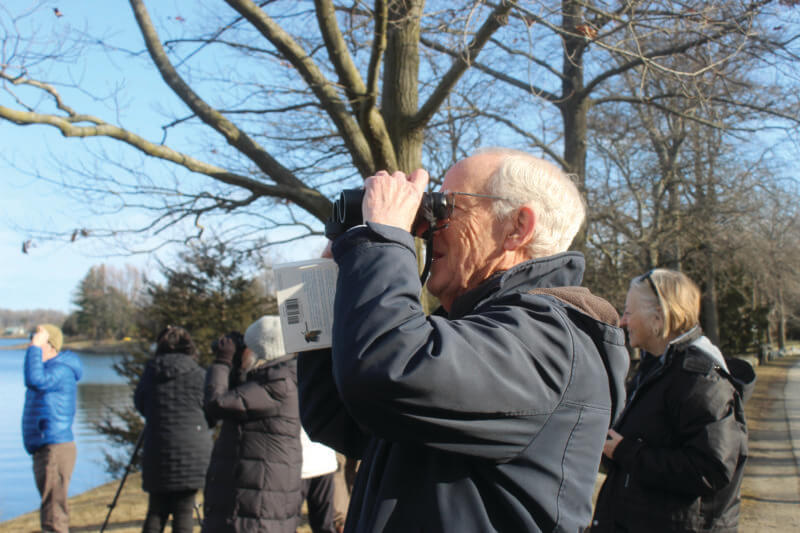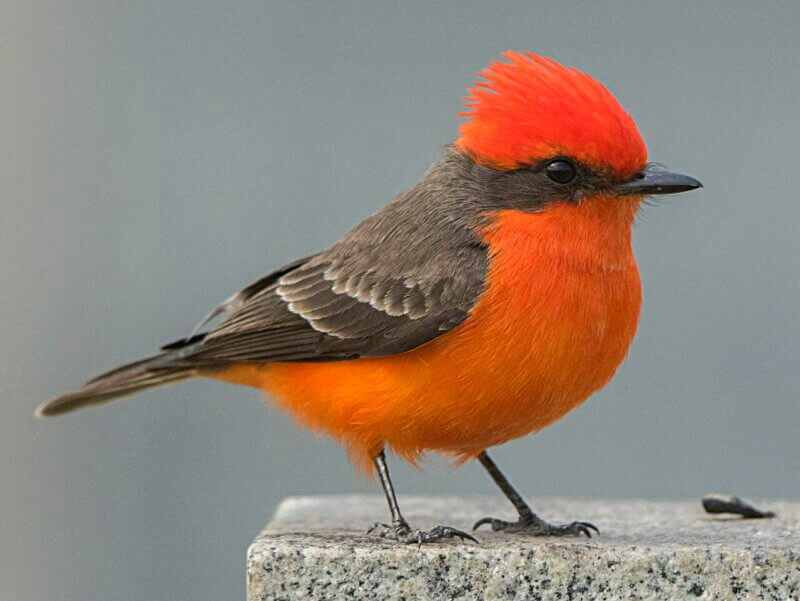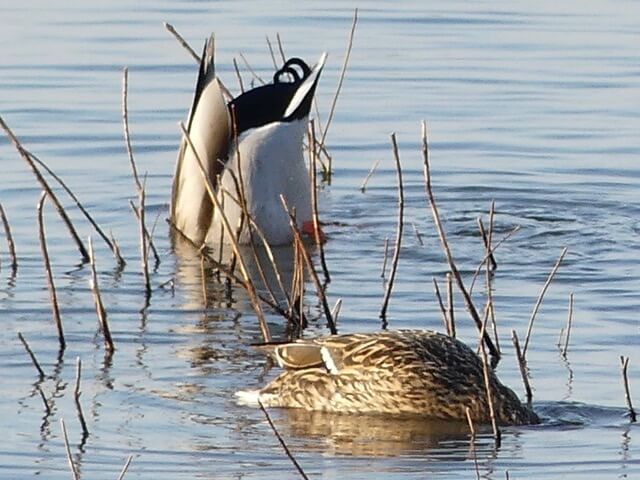Birdwatching as a way of life
In the firmament of Charlotte Senior Center programming, there are lots of stars, but over the years one of its all-stars has been Hank Kaestner.
He has been leading free birding walks for more than 10 years. These often fill up, so make your reservations early.
He recently gave a presentation on vanilla that was packed and that has lots of people clamoring for a repeat. He says he will give it again. He will also give a presentation on cinnamon sometime in the future at a time to be announced and not to be missed.

Hank Kaestner is ranked No. 9 in the world for his birding life list, having seen 8,083 different species of birds. His brother, Peter Kaestner, is ranked No. 1 and is the first person to have reached 10,000 birds.
On March 13, I was lucky enough to get one of the 20 spots on a Kaestner-led birding expedition. It did not disappoint. Although birds figured prominently into his conversation on the excursion, it ended up being about much more than birds.
After a lifetime of birding, it is an understatement to say he knows a lot about our feathered friends. But he also knows a lot about spices and lacrosse. Oh, and by the way, he knows six or seven languages.
The first stop on that Wednesday’s birding trip was the Charlotte Town Beach.
Kaestner starts the birding by calling attention to the talk that Trish O’Kane gave at the Shelburne library, after the newspaper’s deadline but before it was printed this Wednesday, about how birding can change the world. She was also scheduled to give a reading from her book “Birding to Change the World: A Memoir.” He figures, since all of the group are birders, they ought to find out how they can change the world.
He allowed that all his life people have called him a bird brain, and whatever the malcontents may have meant, actually that’s a good thing.
First stop — town beach
Before the group had even left the Charlotte Senior Center parking lot, Kaestner was already identifying birds, pointing out a robin flitting and singing in the trees.
Bird migration for the spring season is already here, he told the group at the town beach.
“A lot of birds are returning to your backyard — redbirds, blackbirds, grackles, bluebirds,” Kaestner said. “All sorts of things are here.”
He set up what he called his “oh-my-god” telescope because usually when people look through it the first time and see the birds, their involuntary response is: “Oh, my god.”
The first bird or birds identified on this expedition were Canada geese.
“All birds are different. You just have to know what to look for. The goldeneye has a golden eye. With the buffleheads it’s the white patch on top,” Kaestner said.
You can even identify a bird by its song with your phone.
Kaestner touts the wonders of eBird, a website managed by the Cornell Lab of Ornithology: “You can take a picture of birds. The camera knows where you are because of global positioning. It’s got a picture; it sends it to the computer at Cornell University where eBird is headquartered.”
Through his telescope Kaestner can even see the golden eye of the goldeneye duck.
Your picture of a bird goes into the database. It confirms the bird in the photo, with the date, the time and the location within 50 feet of where you are and documents it for your bird life list, he said.
I can’t. Apparently, I’m the other kind of bird brain.
There’s breeding loons on Lake Champlain, but they don’t actually breed there. The loons like shallower water, so it’s lucky that there are shallow lakes all over Vermont, perfect for a loon love fest.
Lorraine Johnson, who was serving as bird scribe for this trip and keeping the list of the birds we’d seen, said there were 18 birds on the list at Charlotte Town Beach before the group caravaned over to Shelburne Beach. By the end of the day, the list had over 20 different species of birds on it.
“Doing COVID, that was my winter entertainment, sitting in my kitchen and looking out at all my bird feeders,” Johnson said. “It’s a phenomenal thing to do. It’s just so wonderful.”
Kaestner goes out the day before or morning of a birding expedition to scope out potential birding spots and see where the feathered action is. Sometimes, he will announce a destination only to change it because of bird activity. You don’t know where you’re going with Hank Kaestner until the birding starts.
When we arrived at Shelburne Beach, there are a group of crows that are upset. It takes a few moments to find the source of their consternation. A red-tailed hawk. The flock of crows are darting in and pecking at the much larger predator. Their heroism bolstered by their numbers.
The spark bird
Kaestner has been birding since he was 10 years old.
“Serious birdwatchers have what they call their spark bird. That’s the bird that they saw that gets them interested in birdwatching. I’ve never met a bird watcher that didn’t have a spark bird,” Kaestner said.
His spark bird was a vermilion flycatcher. He was visiting his grandparents in Mexico City when he was 10 years old. Until then he’d been interested in and collecting butterflies, when a brilliant colored bird flew up to the picnic bench where he was sitting.

“As a budding naturalist, I wonder what the name of that bird is,” Kaestner said.
He didn’t have a way to find out then, but the next day he was in a bookstore. There was a bird book with a photo of the bird he had seen the day before on the cover. He bought the book and identified the bird as a vermilion flycatcher, common in the western and southwestern United States, but not so much in Kaestner’s hometown of Baltimore.
He was hooked. Kaestner is the oldest of five brothers, and he got them all interested in birding, eventually even his brother Peter who was 2 years old at the time of Hank’s birding epiphany.
When organizing family events, their father would say, “I’ve got five boys. The oldest is interested in birdwatching; let’s go birdwatching.”
As the years passed, brother Peter Kaestner caught the bird bug big time. So big, that like Hank, he travels the world trying to add to his bird list.
In fact, Peter was written about this month in The New York Times and on the cover of The Baltimore Sun because he is the first person in history to have gotten to 10,000 species on his bird list.
There’s a photo in The New York Times article of Peter Kaestner in the Philippines on Feb. 9, after snapping a photograph of his record-breaking 10,000 bird — an orange-tufted spiderhunter.
According to The Times, 10,000 had once been thought unachievable. Consider that there are only an estimated 11,000 species of birds in the world. And, only 750 in the United States and Canada.
“Fewer than 60 people have ever seen 8,000; fewer than 20 have surpassed 9,000,” according to The New York Times.
‘Coach K’
As his brother got closer to his goal, Hank Kaestner has acquired a new nickname. Coach K. This is a double entendre that is more than doubly appropriate.
Hank Kaestner knew the more famous Coach K, Mike Krzyzewski, who acquired that nickname during his 42-year tenure coaching the Duke Blue Devils and becoming the winningest men’s coach in Division 1 basketball history.
Krzyzewski was the captain of the Army basketball team when Hank Kaestner was a lacrosse coach at West Point in the late 1960s.
After his younger brother detailed in an essay for the American Birding Association how he planned to top the 10,000-bird goal, Hank Kaestner started “coaching” Peter.
Shortly after his brother got off a flight from Taiwan, Hank told him that he had revealed his birding strategy to his nearest competitor on the bird life list. He said Peter needed to get on another plane and fly back out the next day to some place where the odds were good of seeing enough birds to get past the 10,000 birds benchmark.
The next day Peter Kaestner got on a plane bound for the Philippines where he took the title and broke the 10,000 bird mark.
Hank Kaestner said he doesn’t have any jealousy about his brother’s achievement, just the same pride a college professor would have for a student who came up with a discovery that won a Nobel Prize.
Combining work and birding
Both brothers chose professions that were beneficial to their birdwatching pursuits.
Hank traveled the world, buying spice for McCormick, going to 140 countries and planning his travel itinerary so it supplemented his birdwatching
“If you’re flying all the way around the world to Sumatra, where we got our cinnamon, you can go a lot of different ways,” Hank Kaestner said.
He’s gone to Madagascar by way of Brazil to get in some birdwatching along the way.
“My brother was in the State Department. When it was time to choose where he wanted to be, he would be Papua New Guinea or all these crazy places where there were birds,” Hank Kaestner said. “He always got his first choice.”
These two brothers will be joined by another brother for birdwatching in the Philippines next week. The country has around 250 species of birds that are only found there. Hank has the chance to add 75 birds to his list.
“There’s no place in the world where I have the chance for 75 lifers,” Hank Kaestner said.
The birding caravan’s trip to Shelburne Town Beach also provided some avian excitement with the sighting of a greater scaup. Over the years, the bird list for the Charlotte Senior Center trips is just shy of 200 different species of birds. Hank Kaestner said he was going to have to check his records, but he was pretty sure they hadn’t seen a greater scaup on these trips before.

Here a pair of mallards are dabbling. There are two different kinds of ducks — dabbling, who feed by turning upside down, and diving, who like deep water and feed by diving and chasing their prey underwater.
Dabbling vs. diving
Loons and grebes are different from ducks and geese, he explained. There are two different kinds of ducks. The dabbling ducks included mallards, black and pintail ducks who prefer shallow water where they feed by turning upside down.
Diving ducks like deep water and generally remain in the middle of the lake, so a good telescope like the one Hank Kaestner carries is particularly helpful for watching them. They feed by diving and chasing their prey underwater. Scaups, goldeneyes, mergansers and buffleheads are examples of diving ducks.
Kaestner plans to hold another birding walk in early June in the Charlotte Park and Wildlife Refuge. It will be about a two and half mile walk in hopes of seeing birds that like the open country there like bobolinks and indigo buntings. Stay tuned to the senior center calendar for details.
The final stop of the birding expedition was at Shelburne Bay, where there were a bunch of Canadian geese, which we had been seeing all morning.
Although it wouldn’t add to anyone’s bird life list, there was a bit of excitement here in seeing a mink who obliged the group by swimming up to a small rock promontory jutting into the lake, where we were standing. The sleek, black semiaquatic showoff scurried across the point and into the water on the other side.
It seemed like a good way to punctuate the outing.

